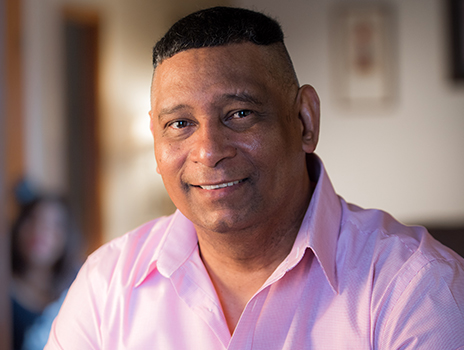- Home
- News Room
- Patient Stories Search Page
- Soldiering Through a Colorectal Cancer Diagnosis
August 13, 2019
A stubbed toe turned into a lifesaving event for Herastico Pitty-Diaz, who might not have learned he had cancer if not for that painful misstep.
After more than 2 decades of service in the U.S. Air Force, Herastico is physically strong and mentally tough. But when he accidentally slammed his big toe against the shower door in August 2015, he cried out in pain, the same as anyone else.
Three months later, the injury continued to bother him so he went to his doctor. His toe checked out fine, but Herastico, 50, learned he was due for a routine colonoscopy. It revealed stage 1 rectal cancer.
After hearing the diagnosis, Herastico said he broke down and wept for an hour. He was especially emotional because his wife, Rosa Elena, had just experienced a miscarriage. Herastico, a devout Catholic, said he prayed and then decided he needed to fight. From that point on, he approached his illness with determination and humor.
“A friend told me that God gives his toughest battles to his strongest soldiers,” he shares.
Battling a colorectal cancer diagnosis
At the urging of a co-worker, he sought care at The University of Kansas Cancer Center.
“My colleague said you better go to The University of Kansas Cancer Center because of their reputation,” says Herastico, who lives in St. Joseph, Missouri. He scheduled an appointment with surgical oncologist John Ashcraft, DO. Dr. Ashcraft ran more tests and determined Herastico’s cancer was actually stage 2.
“Dr. Ashcraft said, ‘This is the plan,' and told me how he was going to do my surgery so I would be good to go,” Herastico says, adding that he appreciated Dr. Ashcraft’s honest, straightforward approach. Dr. Ashcraft collaborated with radiation oncologist Andrew Hoover, MD, and medical oncologist Raed Al-Rajabi, MD, to determine the best treatment plan.
“Our patients go through treatment knowing their team of physicians is communicating and reaching a consensus about the approach that’s right for them. And because we work so closely together in the same building, it’s easy to coordinate care across specialties, adjusting the treatment plan as needed based on how the patient responds,” explains Dr. Hoover.
In addition to surgery, Herastico had chemotherapy and 6 weeks of radiation. During treatment, he stayed at the American Cancer Society’s Hope Lodge, which offers free lodging to cancer patients and their caregivers.
He saw it as a fight, and he put on his boots and moved forward toward a cure. -Raed Al-Rajabi, MD
Medical oncologist
Blessed with humor
Throughout his journey, Herastico says he was surrounded by people eager to be by his side.
“My coworkers took me for treatment every week for 6 weeks, and they stayed with me when I was sick,” he says. While staying at Hope Lodge, Herastico and his wife taught salsa dancing to other residents.
Herastico says he wanted to help people there forget about their illness, often using humor to make light of the challenges he and his fellow patients faced. They appreciated it, as did his doctors.
“Dr. Al-Rajabi told me the percentage of patient survival, but he said with my sense of humor, the percentage was above expectations,” he says.
Dr. Ashcraft also says he admires Herastico’s optimistic attitude.
“Herastico has a very positive outlook and a wonderful sense of humor, as well as great family and co-worker support,” Dr. Ashcraft says. “He almost always had a fellow Air Force airman with him during his visits, and his wife was extremely supportive.”
Dr. Al-Rajabi agrees, adding that Herastico drew upon his military training to remain upbeat and resilient.
“He saw it as a fight, and he put on his boots and moved forward toward a cure,” says Dr. Al-Rajabi.
Herastico’s last surgery was in July 2016 and his cancer is in remission. He goes in for scans every 3 months and has an annual colonoscopy. Herastico is quick to note the compassion and care extended by the entire cancer center team and says the nurses are outstanding.
"The University of Kansas Cancer Center treats you like you are family, not a patient," he says. "The nurses, doctors and staff want to know how comfortable you are, how you’re feeling, what you need. I love the cancer center. Beautiful people are there to care for you."
Giving thanks
Herastico is grateful for his physicians, but he said he also owes a debt of gratitude to Our Lady of Guadalupe, another name for the Blessed Virgin Mary and the patron saint of Mexico.
As he met other cancer patients, Herastico promised each one he would light a candle and place a white rose on the altar of the Basilica of Our Lady of Guadalupe in Mexico City.
This summer, Herastico, and his wife, Rosa, plan to light 48 candles and place 48 white roses at the shrine.
